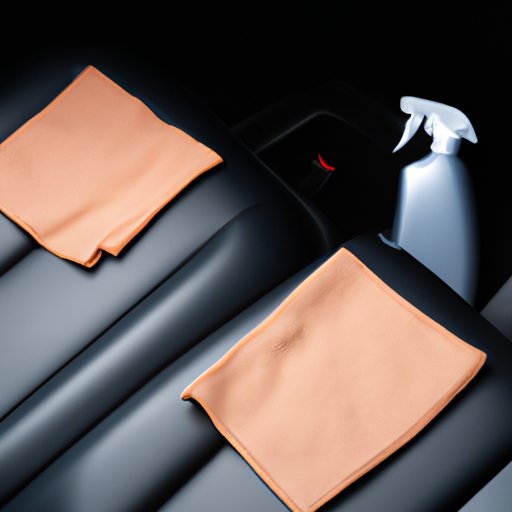
Introduction
Keeping your car seats clean and well-maintained is important not only for the appearance of your vehicle, but also for your health and safety. Dirty car seats can accumulate dirt, bacteria, and unpleasant odors, making them uncomfortable to sit on and potentially harmful to your health. This article will guide you through the step-by-step process of cleaning your fabric car seats effectively, avoiding common mistakes, recommending products, and providing DIY remedies for those who prefer a more natural approach.
Step-by-Step Guide
The first step in cleaning your fabric car seats is to vacuum them thoroughly to remove any loose dirt and debris. Next, prepare a cleaning solution by mixing warm water and a gentle cleaning agent, such as dish soap or a dedicated fabric cleaner. Test the solution on an inconspicuous area of the seat to make sure it doesn’t cause any discoloration or damage.
Dampen a clean microfiber cloth in the cleaning solution, wring out excess water, and start scrubbing the seat gently, using circular motions. Focus on stained or soiled areas, and rinse the cloth frequently to avoid spreading the dirt around. Repeat the process until the seat is clean to your satisfaction, and then rinse the seat with clean water to remove any residue.
To dry the seat, use a dry microfiber cloth to absorb excess moisture, and then leave the car windows open to allow fresh air to circulate. Avoid drying the seat with a blow dryer or any heat source, as this can damage the fabric.
Common Mistakes to Avoid
The most common mistake people make when cleaning fabric car seats is using too much water, or using a cleaning agent that is too harsh. This can cause discoloration, shrinkage, or even water stains that are difficult to remove. Another mistake is using abrasive tools or scrubbing too hard, which can damage the fabric or leave scratches.
To avoid these mistakes, always use a gentle cleaning agent and a soft cloth, and avoid saturating the seat with water. Test the cleaning agent on a small, inconspicuous area first, and rinse the seat with clean water after cleaning. Use circular motions and light pressure, and avoid rubbing too hard or using abrasive tools.
Product Recommendations
When it comes to choosing a cleaning product for your fabric car seats, there are many options available, each with its own pros and cons. A dedicated car upholstery cleaner, such as Meguiar’s Carpet and Upholstery Cleaner, is formulated specifically for cleaning car seats and can penetrate deep into the fibers to remove even stubborn stains and odors.
For those who prefer a more natural approach, there are also eco-friendly products available, such as BioKleen Carpet & Upholstery Cleaner, which uses plant-based ingredients and is safe for both users and the environment.
Whichever product you choose, make sure to follow the instructions carefully and test it on a small area first to avoid any unexpected effects.
Time-Saving Tips
If you’re short on time and need to clean your car seats quickly and efficiently, investing in a handheld vacuum or a cleaning tool that uses steam can be a worthwhile purchase. A handheld vacuum can quickly remove dirt and debris from the seat, while a steam cleaning tool can deep clean the fibers and remove stains without the need for a lot of water or cleaning agents.
Another time-saving tip is to clean your car seats regularly, before they become heavily soiled. A quick vacuum and wipe-down with a microfiber cloth can do wonders in maintaining your car’s interior and preventing dirt and stains from accumulating.
DIY – Home Remedies
For those who prefer a more natural, DIY approach to cleaning their car seats, there are several home remedies that can be effective in removing stains and odors. Baking soda, for example, can absorb unpleasant smells and lift stains when mixed with warm water and applied to the affected area. Vinegar can also be effective in removing stains and odors when mixed with warm water and sprayed onto the seat.
Lemon juice can also be used to remove stains and refresh the seat by mixing it with warm water and applying it to the seat with a cloth. However, be cautious when using lemon juice on light-colored seats, as it can cause discoloration.
Conclusion
Cleaning your fabric car seats regularly is an essential part of maintaining your car’s interior and ensuring your own health and safety. By following this step-by-step guide, avoiding common mistakes, and using the recommended products and DIY remedies, you can achieve a deep, effective clean without damaging the fabric or risking your health.
Remember to vacuum your car seats regularly, test any new products on a small area first, and avoid using too much water or abrasive tools. By keeping your car seats clean and well-maintained, you can enjoy a comfortable, safe, and pleasant driving experience.





